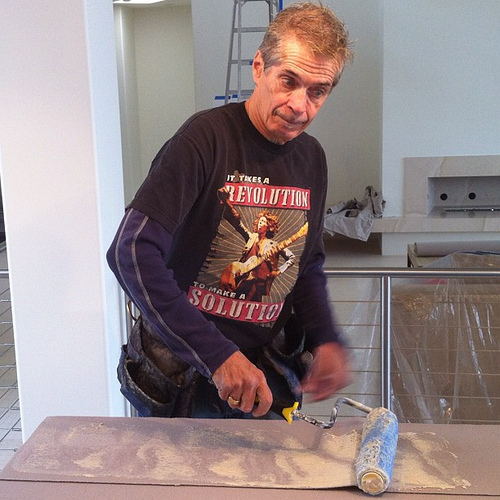Understanding the Cost of Wallpaper Installation

Photo of a master craftsman hanging wallpaper by Jeff Tidwell/Flickr.
Whether you are hanging wallpaper yourself or planning to hire a paperhanger to do it for you, the cost of wallpaper installation can be high. This is why.
Cost of Wallpaper and Supplies
The first obvious factor in the cost of wallpaper installation is, of course, the expense of the rolls themselves. Prices vary considerably, with higher-end and designer wallpapers potentially being quite expensive.
In addition, you’ll need the following supplies and equipment:
- primer for the wall (new drywall must be primed before applying wallpaper)
- razor knife with snap-off blades for cutting the paper
- tape measure
- paint roller and tray
- bucket
- grouting sponge
- smoothing tool
- 4-foot level to make sure paper is hung straight
- possibly, scaffolding and ladders to manage installation in rooms with high ceilings.
Some materials come in a range of prices. Wall primers are a classic example. It may be tempting to go with the cheapest available option, but this could cause problems in the future, including issues with eventual removal. Look at product ratings and performance, and recognize that it may be necessary to spend a little extra for the best choice.
Prep Work
Before a project can even begin, you or your contractor will need to empty the room and examine the wall to determine how much prep work is required. Some processes that may add to the cost of wallpaper installation include removal of one or more layers of old paper, wall priming and preparation, repairs to damaged walls before starting, and special wall treatments that might be required for rooms like bathrooms to prevent warping and bubbling.
Sometimes it’s hard to tell that these cost-elevating measures will be needed until the wall is stripped; for example, in the process of removing old paper, a contractor or homeowner may discover that the underlying wall is damaged and will need to be repaired.
Applying the Wallpaper
Once the wall has been prepared, the paper can be applied. For a room with straight angles and a clean, simple design, putting up wallpaper tends to be a fairly fast activity. However, if a room has curved components, architectural details, or similar challenges, it will take longer to paper and require more skill. This adds to the cost of wallpaper installation not only due to increased labor, but also because more paper is likely to be wasted in the process of cutting it to fit.
Ceiling height is another important factor. High ceilings obviously mean more wall square footage to cover, and might also need scaffolding or lifts to reach.
Labor
Labor must always be a consideration in the cost of wallpaper installation. Contractors include it in their estimates, and so should homeowners preparing to DIY. Think about how long the wallpapering project is likely to take and how that might cut into your time. Consider, as well, what you will do if the project takes longer than anticipated. For example, what happens if you budget a weekend to wallpaper a room and it becomes apparent that the job will take longer? In addition, homeowners may want to consider contingencies like what they will do if they run into trouble and need professional help.
If you intend to hire a contractor to do the work, it is advisable to get multiple bids for comparison purposes, and to research contractors carefully to make sure they’re licensed and qualified, with a good local reputation for the quality of their work.
Updated July 2, 2018.
Looking for a Pro? Call us (866) 441-6648



